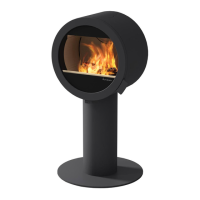Maximum fuel length (cm) 37 cm
Flue outlet Top and rear
Flue (Ø mm)
Outer Ø 150 mm
*Alternative versions
exsists due to National
requirements
Flue gas temperature at ue
connector (°C)
388
Draft at ue connector
recommended (Pa)
15 - 25
Nominal heat output (kW) 5,8
Eciency (%) 79
CO @ 13% O2 (%) 0,07
Flue gas temperature (°C) 324
Draft (Pa) 15
Fuel recommended Wood
Fuel length recomended (cm) 30-35
Fuel charge (kg) 1,20
Refueling interval (minutes) 45
Operation Intermittent*
* Intermittent combustion refers to normal use of a replace, i.e. new
wood is inserted when the previous load has burned down to ember
Warning: If the requirements for ventilation are
NOT complied with, the cooling airow around the
product will be considerably reduced and
the product can overheat.
This can cause a re.
3. Distance to combustible material
Ensure that the safety distances are respected
(FIG 1A and 1B).
When connecting a steel chimney to the top outlet use
the security distances required from the manufacturer.
4. Assembly
• FIG 2 - Rear air connection
• FIG 3 - Bottom air connection
• FIG 4 - Rear ue connection
• FIG 5 - Top ue connection
• FIG 6, 7 - Thermotte plates disassembling
• FIG 8 - Air vent control
Operating control
When the stove is in an upright position, and prior
to connecting it, control that all functions are easy to
manoeuvre and appear satisfactory.
Connecting the ue
Please be aware when connecting the 150 mm ue to
the smoke dome that the ue is placed outside the ue
outlet collar. *Alternative versions exsists due to
National requirements. For the ue connection to the
chimney, follow the recommendations from the chimney
manufacturer.
We recommend a maximum chimney weight of 150
kg.
5. Lighting the re for the rst time
When the stove is assembled and all instructions have
been observed, a re can be lit.
Take care when inserting logs into the burn chamber,
in order not to damage the Thermotte plates. Please
note that there might be some humidity in the insulation
plates which can result in a slower burn rate the rst few
times the stove is used. These will be resolved once the
humidity has evaporated. It is advisable to ventilate
the room well when ring for the rst time as the
varnish on the stove may release some smoke or
smell. Both the smoke and smell will disappear and are
not hazardous.
Lighting a re
Insert small dry pieces of kindling wood,open the air
vent control and ignite. When the ames are stable and
the chimney is warm, the air supply is regulated with the
air vent control.
When there is a glowing layer of ash, new wood logs
can be inserted. Pull the hot ember to the front of the
combustion chamber when inserting new logs so that
the wood is ignited from the front. The re should burn
with bright and lively ames.
Using the stove with low combustion eect and ring
around the clock increase pollution as well as the risk
for a re in the chimney. Never allow the stove or ue
to become glowing red. Turn o the air vent control
should this happen. Regulation of the air vent control
takes some experience, but after a little while a natural
rhythm for the re will be found.
IMPORTANT! Always remember to open the air
vent control when new wood logs are inserted
into a hot burn chamber. Let the ames get
established on the wood before the air supply is
reduced.
When the draught in the chimney is low and
the vents are closed, the gas from the rewood
can be ignited with a bang. This can cause
damages to the product as well as the immediate
environment.

